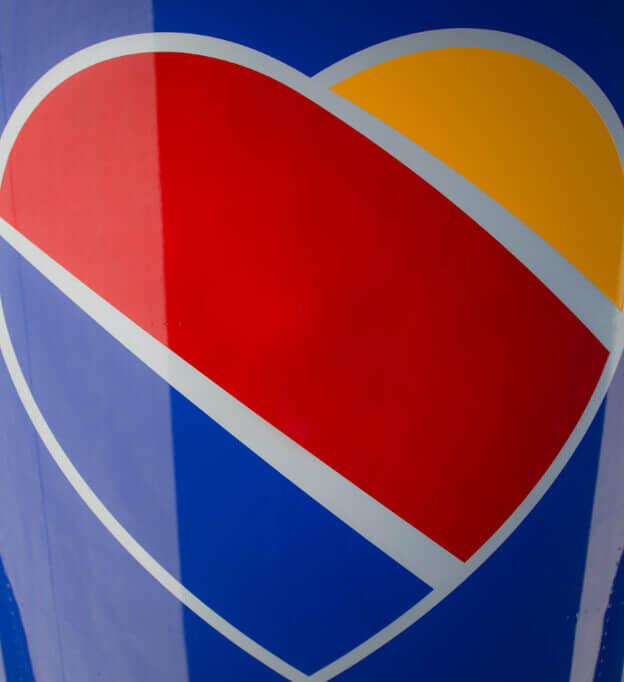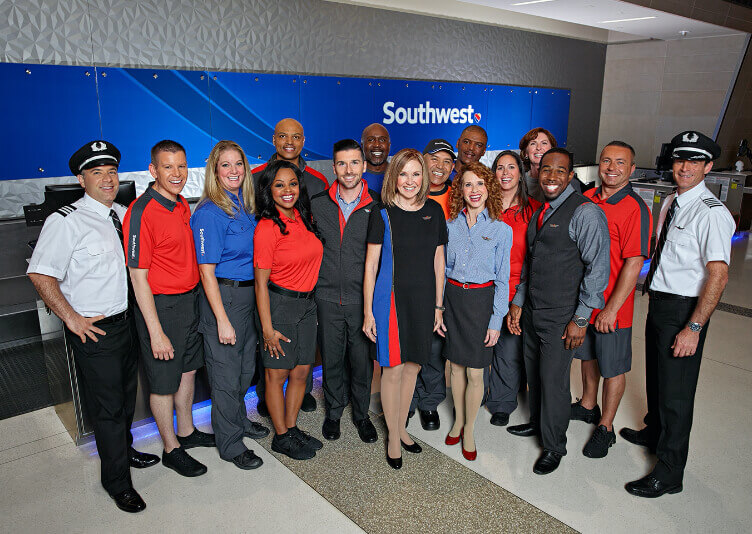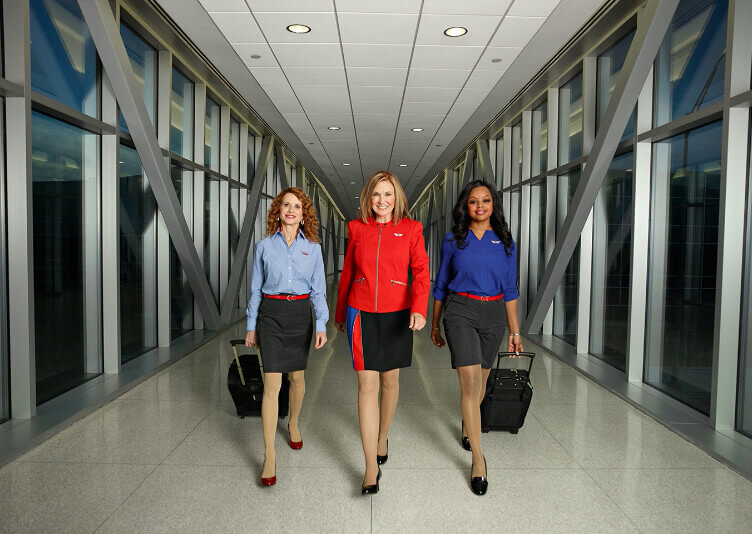
With the new Heart branding refresh, it was time to turn our attention to Employee uniforms.
Bluer Skies: The Great Southwest Uniform Refresh
The dated khakis and slouchy white crew socks were due for retirement. That much became abundantly clear in 2014, when Southwest unveiled its striking new brand identity. The Company’s new Heart logo—striped with sunrise yellow and a warm red—projected a sleekly modern yet soulful look.
The visual identity of Southwest Airlines was clearly evolving, prompting Leadership to green-light a fashionable new uniform upgrade, which would allow Employees to literally embody the Company’s bright new look.
After all, the Company’s current uniforms had more than achieved their initial purpose. When first introduced in 1996, they’d made quite a statement. One couldn’t help but see all those soft-collared polos and casual pants, both above and below the wing, and view Southwest as a remarkably unstuffy airline. The word “comfort” immediately came to mind. Here was an airline whose Employees looked comfortable and extended that sense of comfort to their Customers.
Vice President Inflight Operations Sonya Lacore, a former Flight Attendant who spearheaded the uniform upgrade, wanted to deliver an equally powerful message. To do so, she refused early on to establish any strict parameters. That is, except one: Southwest Employees would be asked to provide an unprecedented amount of input over the look, feel, and design of their own uniforms.
“I know when you’re out doing your job—stretching, bending, lifting, whatever it may be—there is a gap sometimes between what looks good and what feels good,” says Sonya. “[But] I really believed we could have it all. And I knew the only way to do that was to engage Frontline Employees.”
This unabashedly democratic approach didn’t sit well with some early design agency candidates, who also bristled at designing uniforms that would remain in use for more than a few seasons. Nevertheless, Southwest doubled-down on its commitment to Employee involvement. The response from Southwest? Not a problem. We have our own designers, thank you very much. They’re called our Employees.
Things moved quickly from there. Southwest selected a worthy partner and assembled a design Team composed of 43 Employees. It was a diverse group in every sense of the word—no department, size, shape, height, ethnicity, gender, or fashion proclivity was overlooked.

One of the challenges of designing new uniforms was ensuring they worked for the diversity of positions across the Southwest Family.
The group flew to Chicago to perform some undeniably fun research, popping into various shops for inspiration. Cordial but impassioned debates followed, each dissecting the merits and shortcomings of various proposals.
Southwest wanted options—lots of options—so its Employees would never be hemmed into wearing just one ensemble. Thus all concepts, cuts, or colors were open for discussion.
What if we adopted bow ties? No, we are generally not bow-tie people, especially those of us working below the wing. What about shorts—should they stay or should they go? Yes, let’s keep them but redesign them to be more sporty. Color scheme? That’s a tough one. Charcoals and blacks have real possibilities, as do richer primary colors.
And so it went, meeting after meeting, until the Team whittled its approach down to a core set of ideas—a kind of sliding scale consensus. Its guidelines read as follows: We are going to be professional, but not too uptight. We are going to be fun but not hokey. We’re going to be casual, not sloppy.
From there, the beginnings of a striking new catalogue began to emerge. Shorts. Pants. Polos. Blouses. A skirt. Two dresses. When the entire process was complete, 75 pieces would be made available to facilitate mixing and matching. But it was the choice of colors and designs—blues and reds inspired by Southwest liveries set into narrow color stripes that sliced down the hemlines of dresses or over the shoulders of its polos—that ultimately generated the most excitement.
A great deal of work followed in 2015 and 2016. Once fabrics were chosen, Southwest dispatched Team Members overseas to visit potential factories to make sure they were not utilizing child labor or doing anything that would run counter to the integrity of Southwest. Then, early prototypes were provided to 130 Employees to wear on the job and report their feedback.

With bold accents and familiar colors, the new uniforms were the perfect way to bring the Southwest brand to life.
“We did a lot of wear-testing to make sure that they were comfortable, that they were functionable,” said Flight Attendant Tracye Tipps, who was a Design Team Member, “and we did it throughout the entire workgroup.”
Sonya and her Team wanted to know everything. Did certain colors or pieces fade in the wash? How did they hold up in hot and cold weather? Could stains be easily washed out? Some pieces made it, while others proved to be less charming in practice than on paper.
In early 2016, Sonya and her Team realized they’d nailed it. They’d organized a fashion show for Chairman and CEO Gary Kelly and a group of Southwest Leaders in Dallas, complete with a red carpet, music pumping, and positive energy pulsing everywhere.
Initially, everyone’s nerves were frayed. But when members of the Design Team took to the carpet, Leadership rose from their seats, clapping and cheering with unabashed pride.
One initially reticent model, a Southwest Mechanic approached Sonya after the event with tears in her eyes. “I can’t believe it,” she said. “I never thought I’d see the day when I would walk a red carpet.”
When Southwest Employees officially donned the new uniforms in June 2017, a similar sense of pride reverberated through the entire Company. After three years of hard work, one thing was certain: From hemline to neckline, the uniforms were authentically Southwest. Approachable but professional. Comfortable yet chic. Striking and personable.
The uniforms had not been created for the benefit of Customers or to bow to fleeting fashion whims but to make the People of Southwest proud of who they are and how they present themselves, day in and day out.
“I’ll tell you what I did learn through this,” said Sonya, looking back at the experience a few years later. “I already knew what you wear is important but I had no idea it was this important. When they look good, they feel good. And there’s so much power in that.”
